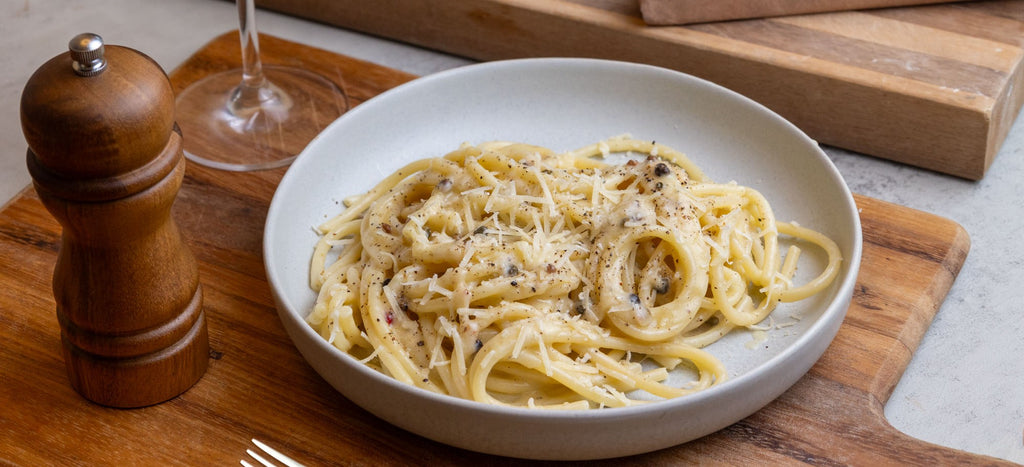Behold: your pairing guide for (almost) every Italian cheese.
We might be biased, but we believe Italian cheeses are some of the best in the world. There are literally hundreds of varieties of cheese made across the country, from soft and milky to long-aged and super funky. Milk from cows, sheep, goats, and even water buffalo is used to make the creamy stuff. And just as every pasta shape has a perfectly paired sauce, every Italian cheese goes best with certain accompaniments, from fruit jams to salumi, nuts, and more.
The Italian cheesemaking tradition goes back millennia to the time of the ancient Greeks, when Sicilian cheese was highly prized and exported across the Mediterranean. The very first cheese to be mentioned by name in literature was Parmigiano Reggiano, way back in the 14th century—and it’s still an international celebrity today! There are dozens of DOP-protected cheese varieties that span the entire country, from Asiago from the Alpine hills of Trentino to Ragusano from the sunny south of Sicily.
With so many different Italian cheeses, many of which are made in small quantities in a particular town or region, we couldn’t possibly cover them all. We’ve listed here the varieties that are best-known and most widely exported outside the country (aka the ones you might see at the cheese counter or in specialty shops). Read on to find the perfect pairing for every Italian cheese, whether you’re building a cheese board for snacking or just looking for mealtime inspiration.

Soft Cheeses
Ricotta: A fresh farmer-style cheese that can be made in minutes, ricotta is creamy and spreadable, with a slight grain. Spread it on crostini and top with bold flavors to play off its mild milky nature; try bitter arbutus honey from Calabria, piquant mostarda from Tuscany, or fragrant wild blueberry jam from Piedmont.
Burrata: A thin layer of fresh mozzarella wrapped around a velvety center of cream and cheese curds, half the fun of eating burrata is cutting into it! Extremely fresh and mild, it pairs well with fresh fruit like persimmons and grapes. Citrus flavors also counter its creaminess; a drizzle of lemon-infused olive oil and some crunchy sea salt will bring it into beautiful balance.
Mozzarella: Mild and slightly chewy, mozzarella is made by pulling a cooked milk “dough” until it forms long strands, which creates the grain of the cheese. Marinate small mozzarella balls (ciliegine) in olive oil and your choice of herbs or seasonings (try dried rosemary or a spice blend like this salt with oregano and chiles). Serve slices of fresh mozzarella with sweet, concentrated sundried tomatoes or salty anchovies to play on some classic pizza flavors.
Robiola: This is the generic name for mild, creamy cheeses from Piedmont that can be made with cow, goat, or sheep's milk, or any combination of the three. Similar to brie, robiola can have a mild mushroom aroma and a thin, edible rind; just like brie, it pairs beautifully with apple butter, fig and plum jams. For a textural contrast, pair with crunchy Piedmont hazelnuts soaked in honey.
Taleggio: For those who love a little more funk, this washed-rind, creamy cheese from Lombardy is the answer. It’s got a powerful aroma but surprisingly moderate, nutty flavor. It’s great for melting and makes the best grilled cheeses ever; try it with Dolcetto wine jelly from the neighboring Piedmont for a sophisticated pair.

Semi-Firm Cheeses
Fontina: Only made in the Val d’Aosta, where it has been a staple since the 12th century, this cow’s milk cheese is distinctly nutty and aged for at least three months in Alpine caves. It has a smooth texture and large holes, similar in appearance to Swiss cheese. Serve Fontina after a meal with fig jam, white truffle-infused honey, and a sweet dessert wine.
Ricotta Salata: This semi-fresh cheese presses the moisture out of sheep’s milk ricotta and then ages it in brine, leaving a crumbly, creamy, salty block similar to feta. It pairs wonderfully with tangy semi-dried tomatoes and black olives; try it in a pasta salad.
Scamorza: Made in the same stretched method as mozzarella, this cheese is hung to age for several weeks, creating its characteristically drooping shape. The aging gives it a firmer, bouncy texture and more complex flavor—some cheesemakers then smoke the cheese over straw, creating Scamorza Affumicata. The smoky cheese pairs beautifully with tangy eggplant caponata.
Provolone: Now made all over Italy, Provolone is originally from Campania. The sliced cheese by this name that you see at the deli is a form of unaged Provolone Dolce; for a more complex experience, look for Provolone Piccante, which is aged for four months or longer and has a funky, sharp flavor and a smooth texture. Try it with artichoke bruschetta.
Gorgonzola: There is a wide world of gorgonzolas out there, from sweet and creamy gorgonzola dolce to crumbly, sharp gorgonzola piccante. They’re all infused with the penicillum bacteria, creating those gorgeous blue veins. Pair milder varieties with cherry jam; spicy aged gorgonzola is a brilliant match for wildflower honey.

Hard Cheeses
Asiago: To make the DOP-protected aged Asiago known as Asiago d’Allevo, cow’s milk cheese is aged in salt for anywhere from a few months to two years, creating a hard, crumbly cheese with a pleasingly yeasty aroma. Serve with soft pretzels and truffle honey mustard for a brilliant game-day snack.
Pecorino Romano: While “pecorino” is the word for a wide range of sheep’s milk cheeses, this variety, from the Lazio region of which Rome is the capital, is the best-known. It’s similar in texture to Parmigiano Reggiano but salty and sharp, and is the zing behind classic Roman pasta dishes like amatriciana. Pair it with other punchy flavors like giardiniera and green olives.
Parmigiano Reggiano: It’s an international celebrity for a reason—this is the peak of Italian cheese. Dry and crumbly with a characteristic graininess, Parmigiano Reggiano can be aged for years, and only gets better with time. It’s bold, nutty, and mouth-tinglingly satisfying; for a truly iconic combination, serve with a drizzle of a sweet, syrupy aged balsamico.























0 comments